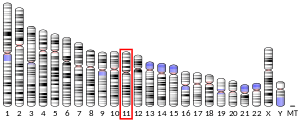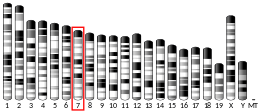Cyclic nucleotide-gated channel alpha 4
Cyclic nucleotide-gated cation channel alpha-4 is a protein that in humans is encoded by the CNGA4 gene.[5][6][7]
CNGA4 is a modulatory subunit of vertebrate cyclic nucleotide-gated membrane channels that transduce odorant signals (Munger et al., 2001).[supplied by OMIM][7]
See also
- Cyclic nucleotide-gated ion channel
References
- GRCh38: Ensembl release 89: ENSG00000132259 - Ensembl, May 2017
- GRCm38: Ensembl release 89: ENSMUSG00000030897 - Ensembl, May 2017
- "Human PubMed Reference:". National Center for Biotechnology Information, U.S. National Library of Medicine.
- "Mouse PubMed Reference:". National Center for Biotechnology Information, U.S. National Library of Medicine.
- Bradley J, Frings S, Yau KW, Reed R (Dec 2001). "Nomenclature for Ion channel Subunits". Science. 294 (5549): 2095–6. doi:10.1126/science.294.5549.2095. PMC 2901924. PMID 11764791.
- Hofmann F, Biel M, Kaupp UB (Dec 2005). "International Union of Pharmacology. LI. Nomenclature and structure-function relationships of cyclic nucleotide-regulated channels". Pharmacol Rev. 57 (4): 455–62. doi:10.1124/pr.57.4.8. PMID 16382102.
- "Entrez Gene: CNGA4 cyclic nucleotide gated channel alpha 4".
Further reading
- Ota T, Suzuki Y, Nishikawa T, et al. (2004). "Complete sequencing and characterization of 21,243 full-length human cDNAs". Nat. Genet. 36 (1): 40–5. doi:10.1038/ng1285. PMID 14702039.
- Kelliher KR, Ziesmann J, Munger SD, et al. (2003). "Importance of the CNGA4 channel gene for odor discrimination and adaptation in behaving mice". Proc. Natl. Acad. Sci. U.S.A. 100 (7): 4299–304. doi:10.1073/pnas.0736071100. PMC 153087. PMID 12649326.
- Strausberg RL, Feingold EA, Grouse LH, et al. (2003). "Generation and initial analysis of more than 15,000 full-length human and mouse cDNA sequences". Proc. Natl. Acad. Sci. U.S.A. 99 (26): 16899–903. doi:10.1073/pnas.242603899. PMC 139241. PMID 12477932.
- Munger SD, Lane AP, Zhong H, et al. (2002). "Central Role of the CNGA4 Channel Subunit in Ca2+-Calmodulin–Dependent Odor Adaptation". Science. 294 (5549): 2172–5. doi:10.1126/science.1063224. PMC 2885906. PMID 11739959.
- Sautter A, Zong X, Hofmann F, Biel M (1998). "An isoform of the rod photoreceptor cyclic nucleotide-gated channel β subunit expressed in olfactory neurons". Proc. Natl. Acad. Sci. U.S.A. 95 (8): 4696–701. doi:10.1073/pnas.95.8.4696. PMC 22553. PMID 9539801.
External links
- CNGA4+protein,+human at the US National Library of Medicine Medical Subject Headings (MeSH)
This article incorporates text from the United States National Library of Medicine, which is in the public domain.
This article is issued from Wikipedia. The text is licensed under Creative Commons - Attribution - Sharealike. Additional terms may apply for the media files.



